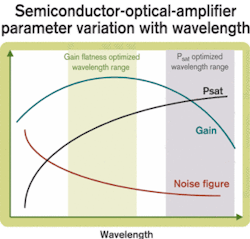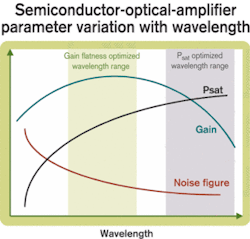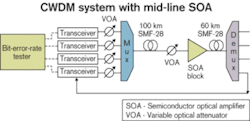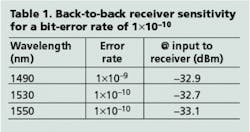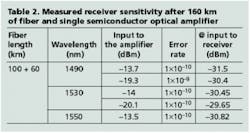Reach extension of CWDM transmission systems using SOAs
Recently, CWDM transmission systems have attracted considerable interest from system providers. By relaxing component tolerances and eliminating the need for cooled transmission sources, CWDM systems offer a cost-effective way of delivering broadband optical services within metropolitan and enterprise networks carrying Gigabit Ethernet, Fibre Channel, OC-3/-12/-48 (STM-1/-4/-16), and cable TV.
The CWDM spectrum covers the wavelength range between 1260 and 1620 nm. Due to high fiber attenuation from Rayleigh scattering, the first two wavelengths are normally neglected, which leaves a total of 18 channels spaced at 20-nm intervals between 1270 and 1610 nm. However, conventional singlemode fibers show significant attenuation around 1400 nm due to the water absorption peak. Consequently, the number of viable CWDM channels drops to 12 channels—three in the range between 1310 and 1350 nm and nine between 1450 and 1610. nm.
Typical (unamplified) transmission distances reported in the field to date range between 40 and 80 km because of the power limitations (around 4 dBm maximum) of the uncooled laser sources used in CWDM systems and the increased losses caused by the addition of more passive devices (optical-add/drop-multiplexer, multiplexer/demultiplexers, and dispersion-compensating modules) to the networks, especially for 10-Gbit/sec data rates. Sometimes, it is desirable to expand transmission distances beyond this range or to improve system power budgets. EDFAs, which are commonly used within DWDM transmission schemes, are impractical because their limited gain bandwidth profile restricts their use to only a small portion of the CWDM spectrum. On the other hand, semiconductor optical amplifiers (SOAs) offer a cost-effective amplification solution over the entire 1.3–1.6-µm window. A balance can be achieved by optimizing the key SOA design parameters to achieve the end-system objectives without compromising the manufacturing processes.
The operation of an SOA within a system context depends on the optimization of five key parameters:
- Gain—gain dispersion or gain flatness.
- Psat—the maximum saturated output power that an SOA can deliver into fiber (normally expressed as the output power where the gain is compressed by 3 dB).
- Noise figure.
- Polarization-dependent gain.
- Ripple on the gain profile.
The degree of importance of each of these parameters depends on the particular application. However, some general observations can be made.
Polarization-dependent gain. It is generally accepted that polarization-dependent gain (PDG) should be as low as possible. Usually, the preferred means of reducing the polarization dependence of the SOA requires the introduction of a tensile strain in the active region. The transverse electric (TE) waveguide mode has a higher confinement factor than the transverse magnetic (TM) mode, but tensile strain makes the TM material gain higher than that of the TE. It is therefore possible to balance the two influences leading to polarization independence. One of the key benefits of this approach is that the confinement factor ratio is substantially constant with waveguide width in most designs, which means that such a design is robust to variations in lithography. With high-quality epitaxial growth, SOAs of this type routinely exhibit less than 0.5-dB polarization dependence across a 30-nm bandwidth. Some SOAs are typically specified to have a PDG value better than 0.5 dB (in the C-band).
Gain ripple. Fabry-Perot cavity ripple can be observed within the gain profile of an SOA. That arises from the fact that an SOA can have a very high chip gain (~30 dB), particularly at the gain peak. However, it is not technically feasible to entirely eliminate all forms of reflection from the facets of the device. Reflectivity values of 10–5 are required for good SOA performance, but the use of antireflection coatings alone can only realistically achieve values of 10–3. To further reduce the reflectivity, the far field distribution must be optimized in association with the facet cleave angle. Through the optimization of these design parameters, SOAs can be generally specified to have ripple values of <0.5 dB across the C-band.
Gain, noise figure, Psat. The procedures for optimizing PDG and the ripple in an SOA are such that they can be tuned independently of other parameters. That is not the case for the remaining three parameters of gain—gain flatness, noise figure (NF), and Psat. Changes in any of these parameters will to some degree influence the other two parameters, and therefore each must be considered within the context of the relevant systems application so their relative importance can be assessed (see Figure 1).The gain profile of the SOA follows a near-Gaussian shape as a function of wavelength. Consequently, the region of minimum gain dispersion (variation of gain with wavelength) lies at the peak of the gain profile, while the gain varies more steeply with wavelengths on either side.
At longer wavelengths than the gain peak (designated in Figure 1 as Psat optimized), the variation in gain with the wavelength is quite pronounced. But within this range, Psat is high and largely invariant, while NF is low and constant. In most circumstances, it is relatively easy to achieve the gain required of an SOA, but good NF and Psat present more exacting targets. Consequently the design of SOAs for C-band applications (~30 nm) has centered on this region. On the other hand, these parameters require more attention to optimize the SOA operation in CWDM applications due to much wider bandwidth (80 nm).
It is important to operate the SOA in the linear region to minimize the channel crosstalk nonlinear effect known as cross gain modulation (XGM). A high Psat is preferred to minimize the influence of chirp and nonlinear effects such as crosstalk. That is achieved by operating the SOA to the right-hand side of the gain peak and using special waveguide designs complemented by high fiber coupling efficiency. Some SOAs combine excellent fiber coupling as well as waveguide design to produce acceptably high Psat values, which can be obtained with relatively low drive currents.
An additional feature of operating at the long wavelength side of the gain peak is that the material inversion factor is high, allowing low NFs to be achieved. Once again, the optimization of the modal profile at the facet of the device is critical, since it determines the coupling to the optical fiber that has a direct bearing on the NF. Some SOAs have facet modal profiles close to rotationally symmetric with a divergence of around 20 degrees full-width half-maximum, which enable extremely high coupling efficiencies when used with 10-µm lensed fiber, resulting in NFs as low as 4.7 dB and a typical product specification of 6.5 dB across the C-band.
The preamplifier (PA) must boost signals at the end of a transmission link to the point where they can be faithfully recovered. Within this context, the critical parameters are gain and NF. The objective of the PA is to boost the optical signal such that the dominant noise process is the beat between the signal and spontaneous emission. The PA must therefore have sufficient gain to ensure that takes place, and generally that means the gain should be around 20 dB or more. Clearly in the case of a PA, the input-signal levels will generally be low, and therefore the NF should be as low as possible.
The PA is much less sensitive to the influence of gain dynamics within the SOA, since the dominant source of the power penalty arises from the dispersion associated with the additional chirp. In the case of the PA, the SOA can be driven significantly into compression (up to 10 dB without catastrophically affecting the receiver performance). Additionally, since the input-signal levels are low, modest saturated output powers are required; therefore, high confinement factor short devices with low current drive requirements are appropriate. Using these design constraints, devices with >20-dB minimum gain, NFs of <5.5 dB and saturated output powers of about 10 dBm can be realized with drive currents of 100 mA. Such devices provide sensitivity improvements of >12 dB compared with an unamplified PIN in combination with a narrowband filter and >9-dB enhancement when no optical filter is used. Losses between the SOA and PIN of up to 10 dB can be tolerated with no loss in sensitivity, allowing inclusion of a demultiplexer in multiple-channel preamplification with no penalty.
Like the preamplifier, the line amplifier (LA) requires high gain since it may be used to amplify small signals, and the NF should be as small as possible. Additionally, the Psat value of the LA is also important since there will be a significant propagation distance after the amplifier. While the PA is insensitive to the influence of the SOA gain dynamic, the chirp associated with the LA must be controlled to a reasonable degree.
Careful design of the SOA, coupled with a clear understanding of the key specifications within a given systems role, allows high-performance SOAs to be produced to address applications within the entire C-band. However, the design process requires that compromises be made between the various wavelength-sensitive parameters. That presents an added challenge for CWDM systems, which have an operational bandwidth of 80 nm. It is evident that an amplifier designed to be a booster in the C-band will have a performance more akin to a PA or an LA for blue-band (1460–1540-nm) or red-band (1540–1620-nm) applications, respectively. In the blue-band, the gain will be higher at lower wavelengths, but the NF may increase slightly and the Psat value will drop off to some degree. Bearing that in mind, it is necessary to move the position of the gain peak of the SOA amplifier, adjust the antireflection coating parameters, and modify the strain and the waveguide design to achieve a line amplifier with an optimum performance.The SOA shown in Figure 2 is characterized by high gain over the entire wavelength range between 1470 and 1530 nm. That, coupled with the fact that the NF is lower than 7 dB across this range, makes the device well suited to both PA and LA applications. The Psat value has a minimum of 9.5 dBm at 1470 nm rising to 13 dBm at 1530 nm, while the gain ripple is consistently lower than 0.5 dB. The PDG value varies significantly across the band from 2 dB at 1470 nm to almost 0 dB at 1530 nm. That can be further tuned with a change of material strain to better than 1.5 dB across the band. Although these specifications are lower than what could be achieved over a narrower wavelength range, such as in the C-band, they do none-the-less demonstrate that excellent amplification properties can be obtained over this wide wavelength range. These characteristics can meet the requirements for a variety of CWDM applications. Similar performance characteristics are achievable with SOAs optimized for L-band operation.
Reach extension of CWDM systems, using low-cost SOAs, gives system designers an added degree of flexibility and thus enhances the utility of the CWDM approach. The additional system margin provided by an SOA can be used to increase the transmission distance, compensate for losses within a node, or facilitate the implementation of ring architectures where signals may arrive at their destination from a variety of routes.
Two kinds of CWDM amplifier circuit packs can extend the reach of data transmission: inline amplifier and preamplifier. The CWDM operating wavelength range is divided into two bands, blue and red, allowing four channels to be amplified at a time.
A field evaluation trail was conducted using a mid-span LA module and a four-channel CWDM transmission system at 2.488 Gbits/sec, covering the wavelength range between 1490 and 1550 nm (see Figure 3). The amplifier circuit pack contained monitor photodiodes on the input and output as well as variable optical attenuators (VOAs) to fix the maximum output power to a value of +1 dBm per channel. The amplifier module was located 100 km into a 160-km span of SMF-28 fiber. The module was based around an SOA optimized to provide high gain (18-dB minimum across the wavelength band), coupled with a low NF (<7 dB across the band). The PDG of the SOA was <1 dB and the gain ripple was <0.2 dB.Key physical characteristics of SOAs include gain, NF, Psat, PDG, and gain ripple. The interplay of each of these parameters within the context of telecommunications systems can be balanced and optimized in the process of designing the SOA for a particular application. With careful design, the performance characteristics of an SOA optimized for CWDM operation can be achieved over the extended wavelength range necessary for CWDM transmission schemes.
Ahmad Atieh is a senior optical engineer and Paul Vella is vice president of manufacturing at BTI Photonic Systems (Ottawa, Ontario). Craig Michie is applications manager and Bob Press is vice president of marketing at Kamelian (Yarnton, UK). Tony Kelly, formerly vice president of device design at Kamelian, is now with the University of Glasgow.
